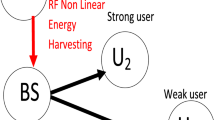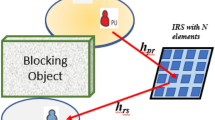Abstract
In this work, we investigate and analyse the performance of the energy detector over Weibull–Shadowed composite fading channel. To this end, we have derived the novel expressions for the probability of detection (PD) and the average area under the receiver operating characteristic curve (AUC). Furthermore, the asymptotic analysis of such performance metrics has been carried out and the simpler and closed-form expressions of the PD and the average AUC have been proposed with maximal ratio combining, equal gain combining, and selection combining diversity schemes. Finally, the derived results have been applied to cooperative system considering erroneous channel between secondary users and a fusion center. The derived expressions are valid for both integer and non-integer values of the multipath and shadowing parameters. The derived analytical results are corroborated by both exact numerical results and Monte-Carlo simulations, and it is shown that the performance of cooperative system not only depends on the parameters of composite fading distribution but also on the erroneous feed-back channel.







Similar content being viewed by others
References
Sagias, N. C., Karagiannidis, G. K., Bithas, P. S., & Mathiopouls, P. T. (2005). On the correlated weibull fading model and its applications. In IEEE 62nd Vehicular Technology Conference (pp. 2149–2153).
Bouanani, F. El. (2014). A new closed-form approximations for MRC receiver over non-identical weibull fading channels. In Proceedings of the international wireless communications and mobile computing conference (IWCMC).
Bouanani, F. El., & Ben-Azza, H. (2015). Efficient performance evaluation for EGC, MRC and SC receivers over weibull multipath fading channel. In Proceedings of the international conference on cognitive radio oriented wireless networks (pp. 346–357).
Ibdah, Y., & Ding, Y. (2015). Mobile-to-mobile channel measurements at 1.85 GHz in suburban environments. IEEE Transactions on Communications, 63(2), 466–475.
Bessate, A., & Bouanani, F. E. (2016). A very tight approximate results of MRC receivers over independent weibull fading channels. Physical Communication, 21, 30–40.
Héliot, F., Xiaoli, C., Hoshyar, R., & Tafazolli, R. (2009). A tight closed-form approximation of the log-normal fading channel capacity. IEEE Transactions on Communications, 8(6), 2842–2847.
Khandelwal, V., & Karmeshu, (2014). A new approximation for average symbol errorprobability over log-normal channels. IEEE Wireless Communications Letters, 3(1), 58–61.
Khandelwal, V., Kaushik, R., & Jain, R. C. (2017). A simple closed form approximation of average channel capacity for weakly turbulent optical wireless links. Wireless Personal Communications, 95(3), 2665–2677.
Chauhan, P. S., & Soni, S. K. (2018). New analytical expressions for ASEP of modulation techniques with diversity over lognormal fading channels with application to interference-limited environment. Wireless Personal Communication, 99(2), 695–716.
El Ayadi, M. H., Ismail, M. M. H., & Alhennawi, H. R., (2016). Unified approach for probability of detection evaluation over generalized fading channels. IET Communications, 10(12), 1532–1541.
Sofotasios, P. C., Fikadu, M. K., Ho-Van, K., & Valkama, M. (2013). Energy detection sensing of unknown signals over weibull fading channels. In The 2013 international conference on advanced technologies for communications (pp. 414–419).
Dalai, D. P., & Anuradha, S. (2015). Co-operative spectrum sensing for cognitive radio systems over fading channels. In 3rd International conference on signal processing, communication and networking (ICSCN).
Atapattu, S., Tellambura, C., & Jiang, H. (2010). Performance of an energy detector over channels with both multipath fading and shadowing. The IEEE Transactions on Wireless Communications, 9(12), 3662–3670.
Alhennawi, H. R., Ismail, M. H., & Mourad, H.-A. M. (2014). Performance evaluation of energy detection over extended generalised-\(\cal{K}\) composite fading channels. Electronics Letters, 50(22), 1643–1645.
Peppas, K. P., Efthymoglou, G., Aalo, V. A., Alwakeel, M., & Alwakeel, S. (2015). Energy detection of unknown signals in Gamma-shadowed Rician fading environments with diversity reception. IET Communications, 9(2), 196–210.
Chauhan, P. S., Tiwari, D., & Soni, S. (2017). New analytical expressions for the performance metrics of wireless communication system over weibull/lognormal composite fading. International Journal of Electronics and Communications (AEU), 82, 397–405.
Abramowitz, M., & Stegun, A. I. (1972). Handbook of mathematical functions with formulas, graphs, and mathematical tables. New York: Dover Publications Inc.
Simon, M. K., & Alouini, M. (2005). Digital communication over fading channels (2nd ed.). New York: Wiley.
Atapattu, S., Tellambura, C., & Jiang, H. (2010). Analysis of area under the ROC curve of energy detection. The IEEE Transactions on Wireless Communications, 9(3), 1216–1225.
Annamalai, A., Olabiyi, O., Alam, S., Odejide, O., & Vaman, D. (2011). Unified analysis of energy detection of unknown signals over generalized fading channels. In Proceedings of the 7th international on wireless communications and mobile computing conference (IWCMC) (pp. 636–641).
Adamchik, V. S., & Marichev, O. I. (1990). The algorithm for calculating integrals of hypergeometric type functions and its realization in reduced system. New York: ACM.
Gradshteyn, I. S., & Ryzhik, I. M. (2007). Table of integrals, series, and products (7th ed.). California: Academic Press.
http://functions.wolfram.com/HypergeometricFunctions/MeijerG/21/02/03/01/. Accessed 28 August 2017.
Hanley, J. A., & McNeil, B. J. (1982). The meaning and use of the area under a receiver operating characteristic (ROC) curve. Radiology, 143, 29–36.
Prudnikov, A. P., Brychkov, Y. A., & Marichev, O. I. (1986). Integrals and series volume 2: Special functions (1st ed.). London: Gordon and Breach Science Publishers.
Rana, V., Chauhan, P. S., Soni, S. K., & Bhatt, M. (2017). A new closed-form of ASEP and channel capacity with MRC and selection combining over Inverse Gaussian shadowing. International Journal of Electronics and Communications (AEU), 74, 107–115.
Prudnikov, A. P., Brychkov, Y. A., & Marichev, O. I. (1986). Integrals and series volume 3: More special functions (1st ed.). London: Gordon and Breach Science Publishers.
Quan, L., Jun, G., & Lesheng, C. (2010). Optimization of energy detection based cooperative spectrum sensing in cognitive radio networks. In International conference on wireless communications and signal processing (WCSP) (pp. 1–5).
Wei, Z., Ranjan, K. M, & Khaled Ben, L., (2009). Optimization of cooperative spectrum sensing with energy detection in cognitive radio networks. The IEEE Transactions on Wireless Communications, 8(12), 5761–5766.
Althunibat, S., Di Renzo, M., & Granelli, F. (2013). Optimizing the K-out-of-N rule for cooperative spectrum sensing in cognitive radio networks. In 2013 IEEE proceedings of the global communications conference (GLOBECOM) (pp. 1607–1611).
http://functions.wolfram.com/GammaBetaErf/Gamma2/20/01/02. Accessed 03 October 2017.
Soulimani, A., Benjillali, M., Chergui, H., & da Costa, D. B. (2015). Performance analysis of M-QAM multihop relaying over mm wave weibull fading channels. In International conference on wireless networks and mobile communications (WINCOM15) (pp. 1–19).
Loo, C. (1985). A statistical model for a land mobile satellite link. IEEE Transactions on Vehicular Technology, 34, 122–127.
Loo, C. (1990). Digital transmission through a land mobile satellite channel. IEEE Transactions on Communications, 38, 693–697.
Author information
Authors and Affiliations
Corresponding author
Rights and permissions
About this article
Cite this article
Chauhan, P.S., Soni, S.K. Modelling and Performance Analysis of Energy Detector Over Weibull–Shadowed Fading Channel with Application to Cooperative Sensing. Wireless Pers Commun 103, 2791–2809 (2018). https://doi.org/10.1007/s11277-018-5963-3
Published:
Issue Date:
DOI: https://doi.org/10.1007/s11277-018-5963-3




